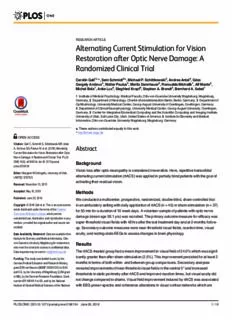
Alternating Current Stimulation for Vision Restoration after Optic Nerve Damage PDF
Preview Alternating Current Stimulation for Vision Restoration after Optic Nerve Damage
RESEARCHARTICLE Alternating Current Stimulation for Vision Restoration after Optic Nerve Damage: A Randomized Clinical Trial CarolinGall1☯*,SeinSchmidt2☯,MichaelP.Schittkowski3,AndreaAntal4,Géza GergelyAmbrus4,WalterPaulus4,MoritzDannhauer5,RomualdaMichalik1,AlfMante2, MichalBola1,AnkeLux6,SiegfriedKropf6,StephanA.Brandt2,BernhardA.Sabel1 1 InstituteofMedicalPsychology,MedicalFaculty,Otto-von-GuerickeUniversityMagdeburg,Magdeburg, Germany,2 DepartmentofNeurology,Charité-UniversitätsmedizinBerlin,Berlin,Germany,3 Departmentof a11111 Ophthalmology,UniversityMedicalCenter,Georg-AugustUniversityofGoettingen,Goettingen,Germany, 4 DepartmentofClinicalNeurophysiology,UniversityMedicalCenter,Georg-AugustUniversity,Goettingen, Germany,5 CenterforIntegrativeBiomedicalComputingandtheScientificComputingandImagingInstitute, UniversityofUtah,SaltLakeCity,Utah,UnitedStatesofAmerica,6 InstituteforBiometryandMedical Informatics,Otto-von-GuerickeUniversityMagdeburg,Magdeburg,Germany ☯Theseauthorscontributedequallytothiswork. *[email protected] OPENACCESS Citation:GallC,SchmidtS,SchittkowskiMP,Antal A,AmbrusGG,PaulusW,etal.(2016)Alternating Abstract CurrentStimulationforVisionRestorationafterOptic NerveDamage:ARandomizedClinicalTrial.PLoS ONE11(6):e0156134.doi:10.1371/journal. Background pone.0156134 Visionlossafteropticneuropathyisconsideredirreversible.Here,repetitivetransorbital Editor:MargaretMDeAngelis,UniversityofUtah, alternatingcurrentstimulation(rtACS)wasappliedinpartiallyblindpatientswiththegoalof UNITEDSTATES activatingtheirresidualvision. Received:November15,2015 Accepted:May10,2016 Methods Published:June29,2016 Weconductedamulticenter,prospective,randomized,double-blind,sham-controlledtrial Copyright:©2016Galletal.Thisisanopenaccess inanambulatorysettingwithdailyapplicationofrtACS(n=45)orsham-stimulation(n=37) articledistributedunderthetermsoftheCreative for50minforadurationof10weekdays.Avolunteersampleofpatientswithopticnerve CommonsAttributionLicense,whichpermits damage(meanage59.1yrs)wasrecruited.Theprimaryoutcomemeasureforefficacywas unrestricteduse,distribution,andreproductioninany medium,providedtheoriginalauthorandsourceare super-thresholdvisualfieldswith48hrsafterthelasttreatmentdayandat2-monthsfollow- credited. up.Secondaryoutcomemeasureswerenear-thresholdvisualfields,reactiontime,visual DataAvailabilityStatement:Dataareavailablefrom acuity,andresting-stateEEGstoassesschangesinbrainphysiology. InstituteforBiometryandMedicalInformatics,Otto- von-GuerickeUniversityMagdeburgforresearchers Results whomeetthecriteriaforaccesstoconfidentialdata. [email protected] ThertACS-treatedgrouphadameanimprovementinvisualfieldof24.0%whichwassignif- icantlygreaterthanaftersham-stimulation(2.5%).Thisimprovementpersistedforatleast2 Funding:Thisstudywasfundedinpart,bythe GermanFederalEducationandResearchMinistry, monthsintermsofbothwithin-andbetween-groupcomparisons.Secondaryanalyses grantERA-netNeuron(BMBF01EW1210)toBAS revealedimprovementsofnear-thresholdvisualfieldsinthecentral5°andincreased andCG,bytheUniversityofMagdeburg(LOM-grant thresholdsinstaticperimetryafterrtACSandimprovedreactiontimes,butvisualacuitydid toMB),bytheGermanResearchFoundation,Grant notchangecomparedtoshams.VisualfieldimprovementinducedbyrtACSwasassociated numberBR1691/8-1toSS,andbytheNational InstituteofGeneralMedicalSciencesoftheNational withEEGpower-spectraandcoherencealterationsinvisualcorticalnetworkswhichare PLOSONE|DOI:10.1371/journal.pone.0156134 June29,2016 1/19 AlternatingCurrentStimulationforVisionRestoration InstitutesofHealth(USA)undergrantnumberP41 interpretedassignsofneuromodulation.Currentflowsimulationindicatescurrentinthe GM103545-17toMD,andbyEBS(Germany).The frontalcortex,eye,andopticnerveandinthesubcorticalbutnotinthecorticalregions. fundershadnoroleinstudydesign,datacollection andanalysis,decisiontopublish,orpreparationof Conclusion themanuscript. rtACStreatmentisasafeandeffectivemeanstopartiallyrestorevisionafteropticnerve CompetingInterests:Theauthorshavedeclared thatnocompetinginterestsexist. damageprobablybymodulatingbrainplasticity.Thisclass1evidencesuggeststhatvisual fieldscanbeimprovedinaclinicallymeaningfulway. Abbreviations:ACS,alternatingcurrentstimulation; CSF,conductivecerebrospinalfluid;HRP,high resolutionperimetry;QoL,qualityoflife;tDCS, TrialRegistration transcranialdirectcurrentstimulation;rtACS, repetitivetransorbitalalternatingcurrentstimulation; ClinicalTrials.govNCT01280877 VF,visualfield. Introduction Opticneuropathyandglaucomaarefrequentcausesofchronicblindness[1].Afteraspontane- ousrecoveryperiod,visualfield(VF)lossisconsideredirreversiblewhichcompromisesvision- relatedqualityoflife(QoL)[2–4].Asystematicsearchforameanstoimprovesuchvisionloss isurgentlyneeded. Transcranialdirectcurrentstimulation(tDCS)andalternatingcurrentstimulation(ACS) ofthebrainarenewmethodstomodifybrainexcitabilityandsynchronicityinhealthysubjects andpatientswithbraininjuriesaffectingdifferentmodalitiessuchasthemotor[5],language [6],orsomatosensorydomains[7].Inthevisualsystem,exploratoryevidenceindicatesthat ACScanenhanceneuronalfunctionbothinnormalsubjects[8–9]andinpatientswithVFloss whostillhavesomeresidualvision[10].Theproposedmechanismofactionisneuromodula- tionofoscillatorybrainactivitytowardsamoresynchronizedEEGviaentrainmentofspecific stimulationfrequencies[10–11],andthereorganizationofbrainfunctionalconnectivitynet- works[12]isconsideredtobeanovelandpromisingavenueforvisualrehabilitation[13]. Inasmallsamplestudy,ACSwasdeliveredinfrequenciesrangingfromthetatohighbeta viaelectrodesplacedneartheeyetore-activateresidualvisioninopticneuropathy[14].Here, 10dailyrtACSsessionsincreasedlightdetectionperformanceandimprovedpatient-reported vision-relatedQoLwhichwasmoderatelycorrelatedwithVFgains[15].Theseimprovements wereassociatedwithincreasedalpha-poweratoccipitalsitesinresting-EEGs[14,16]and increasedneuronalsynchronizationoffunctionalconnectivitiesbetweentheoccipitaland frontalregions[12].Yet,thelevelofclinicalevidenceisstillnotdefinitivebecausethetrials includedonlysmallpatientsamples[12,14–16].Wehypothesizedthatefficacyandsafety couldbedocumentedinalargersampleprospectivetrial. Wenowreportthefirstconfirmatory,large-sample,doubleblind,randomized,multi-center clinicaltrialtoestablishtheefficacyandsafetyofrtACSstimulationinpatientswithvision impairmentscausedbyopticnervedamage. Methods Studydesign ThetrialflowdiagramandstudydesignareshowninFig1Aand1B.Diagnosticevaluations wereconductedatBASELINE,aftercompletionofthe10-daytreatment(POST),andaftera 2-monthtreatment-freeinterval(FOLLOW-UP).TheCONSORTchecklist(S1File)andstatis- ticalanalysesprotocol(S2File)areincludedassupportinginformation. PLOSONE|DOI:10.1371/journal.pone.0156134 June29,2016 2/19 AlternatingCurrentStimulationforVisionRestoration Fig1.Consortflowchartandstudydesign.(A)Patientflowforcasesincludedintheprimaryoutcome measureanalysis.Of98eligiblepatients,45weretreatedwithrtACSand37withsham-stimulation.Five subjectsleftthestudybetweeninitialscreeningandBASELINEfordifferentreasonsandanotherfive subjectswereexcludedduetoviolationofaninclusioncriterion(unacceptablefluctuationsbetweeninitial screeningandBASELINE).Duringthetreatmentphasethreesubjectsdroppedoutbecauseofmedical PLOSONE|DOI:10.1371/journal.pone.0156134 June29,2016 3/19 AlternatingCurrentStimulationforVisionRestoration conditionsthatwereunrelatedtostudyparticipation.Threetreatedcasesoflegallyblindsubjectswere excludedfromsubsequentanalysesduetoviolationofinclusioncriterion(noresidualvision).(B)Study designwithdiagnosticandtreatmentvisits.RandomizationwasdoneafterBASELINEassessment.Stability ofVFdefectswasascertainedbycomparingVFsatBASELINEwiththoseobtainedduringthescreeningvisit 2weeksearlier.Uponcompletionofthe10-daytreatment,allinitialdiagnostictestswererepeated(POST). TheFOLLOW-UPdiagnosticassessmentwasconductedafteratherapy-freeintervalofatleast2months. doi:10.1371/journal.pone.0156134.g001 Thestudydesignwasprospectiveanddoubleblind;neitherthepatientsnorthediagnostic examinerswereawaretowhichtreatmentarmthepatientbelonged.Forallocationconceal- ment,patientsofthesham-groupreceivedminimaldosestimulation.Theinvestigatoradmin- isteringthetreatmentwasawareofthegroupidentitybutwasinstructednottorevealtothe patientswhichtreatmenttheyreceived.Patientswereinformedtowhichgrouptheybelonged onlyaftertheFOLLOW-UPtests,andallsham-stimulationpatientswereofferedrtACS. Informedwrittenconsentwasobtainedpriortorandomization.Studyparticipantsreceiveda compensationforstudyparticipation.Theethicscommitteesoftheparticipatingstudycenters inMagdeburg,Berlin,andGoettingenapprovedthestudy,andastatisticalanalysisplanwas filedwiththeleadethicscommittee.ThestudywasconductedaccordingtotheDeclarationof HelsinkiandregisteredatClinicalTrials.gov(NCT01280877).ThetrialwasregisteredinJanu- ary2011uponreceivingapprovalfromtheleadingethicscommitteeinDecember2010.The daterangeforpatientrecruitmentandfollow-upwasfromDecember2010untilFebruary 2012.Theauthorsconfirmthatallongoingandrelatedtrialsforthisinterventionare registered. Studysampledescription Patientswhosufferedvisualfieldlosscausedbyglaucoma(n=33)orAION(n=32)wereran- domized.Thefollowingetiologiesofopticatrophywerealsoincluded:post-acuteinflamma- tion(n=12),opticnervecompression(n=5,ofwhich4weretumor-inducedand1 intracranialhemorrhage),congenitalorunknownetiologyofopticatrophy(n=5),andLeber's hereditaryopticneuropathy(n=3).Eightpatientshadtwoconcomitantdiagnosesofoptic nerveatrophy.Thesamplesizesateachstudycenterwereasfollows:CharitéBerlin(n=33), Otto-von-GuerickeUniversityMagdeburg(n=31),andDepartmentofOphthalmology, Georg-AugustUniversityofGoettingen/EyeClinicKassel(n=18).Table1summarizesthe demographicsandlesionvariables.WithrespecttoBASELINEvariables,resultsdidnotsignifi- cantlydifferbetweenthertACS-andthesham-group(Table2). Samplesizeandrandomization ThesamplesizecalculationwasbasedonresultsoftwoearlierpilotstudiesattheInstituteof MedicalPsychology(UniversityofMagdeburg)consideringsimilarpatientsandequivalent stimulationschemes,i.e.,rtACS-andsham-groupsasinthepresenttrial.Inthefirsttriala meanpercentageincrease(±standarddeviation)of65.61±104.35wasobservedinthertACS- group(n=19)and16.93±31.22inthesham-group(n=14).Thecorrespondingresultsofthe subsequenttrialwere30.68±41.97inthestimulationgroup(n=12)and9.57±12.05(n=13) fortheshamgroup.Usingthesemeansandstandarddeviationsinasamplesizecalculation (α=0.05,two-sided,power1–β=0.80)foratwo-samplet-test(Satterthwaiteversion)with nQueryAdvisor7.0resultedin41patientspergroupforthefirsttrialand36patientsper groupforthesecondtrial.Therefore,weadoptedaconservativeapproachofconsideringupto 10percentdrop-outandplannedtorecruit45patientspergroup.Patientswereassignedto eitherthertACS-orthesham-groupby“RandomizationInTreatmentArms”software(RITA, PLOSONE|DOI:10.1371/journal.pone.0156134 June29,2016 4/19 AlternatingCurrentStimulationforVisionRestoration Table1. Patients’demographicsandlesioncharacteristics. rtACS-group Sham-group p Samplesize,n 45 37 Age(years),mean±standarderrormean(SEM) 57.8±14.2 60.7±11.6 0.563 Male,(%) 71.1 40.5 0.005 Lesionage, 6–12months(%) 13.9 7.4 0.206 righteye 1–2years(%) 8.3 0.0 >2years(%) 77.8 92.6 Lesionage, 6–12months(%) 8.3 14.8 0.468 lefteye 1–2years(%) 16.7 7.4 >2years(%) 75.0 77.8 singlediagnosis 88.9 89.2 0.965 dualdiagnosis 11.1 10.8 Binocularlesionsn(%)1 60.0 46.0 0.442 Monocularlesions,oneeyeintact(%) 31.1 45.9 Monocularlesions,oneeyeblind(%) 8.9 8.1 1Incaseswithbinocularvisionlossbotheyeswereaveragedforsubsequentanalyses.P-valuesarereportedforWilcoxon-Mann-WhitneyUtests,two- sidedandPearson-Chi-Squaretests,two-sided. doi:10.1371/journal.pone.0156134.t001 StatSol,Lübeck)withstratifiedblockrandomizationconsideringthestudycenterandtheVF defectdepthatBASELINEaspotentialprognosticfactors.Highvs.lowdefectdepthwas definedasstimulusdetectionratesbelowvs.above30%insidetheVFdefect. Randomizationresultedincomparableaveragebaselinesituationanddemographicsinthe rtACS-andsham-group.Onlythepercentageofmalesvs.femaleswasunequallydistributed butthiswasindependentofstudyresults. Inclusionandexclusioncriteria Thefollowingcriteriawereestablishedprospectively.Inclusioncriteriaincluded:(i)stableVF defectwithresidualvisionasdetectedbysuper-thresholdperimetrytesting(HRP,cut-off1.5% inatleastoneeye);(ii)lesionage>6months;(iii)patientage>18yrs;(iv)compliancewith theexperimenters’instructionsduringdiagnostictesting;and(v)sufficientfixationability. Exclusioncriteriaincluded:electricorelectronicimplants(suchascardiacpacemaker);any metalartifactsintheheadortruncusarea(withtheexceptionofdentalimplants);epilepsyand photo-sensibility;acuteauto-immunediseases;psychiatricdiagnoses;diabeticretinopathyor otherdocumentedretinalimpairments;highbloodpressure(>160/100mmHg);acutecon- junctivitis;retinitispigmentosa;pathologicalnystagmus;anunstableorhighlevelofintraocu- larpressure(>27mmHg);andpresenceofanun-operatedtumororcancerrecurrence anywhereinthebody. Statisticalanalysesandstudyendpoints Primarydataanalysiswasconductedindependentlybythebiometrydepartmentoftwoofthe coauthors(A.L.,S.K.)andincludedsamplesizecalculation,statisticalanalysisplan,initializa- tionofrandomizationanddatasourceverification.Primaryandsecondaryendpointswere definedprospectively. VFmappingwasconductedusingacampimetric,high-resolution,super-thresholdvisual detectiontest(HRP)[17],amethodthatrevealsareasofresidualvisioninthecentralVFwith PLOSONE|DOI:10.1371/journal.pone.0156134 June29,2016 5/19 AlternatingCurrentStimulationforVisionRestoration Table2. VisualfieldcharacteristicsatBASELINEaccordingtotreatmentarms. rtACS-group Sham-group p High-resolutionperimetry DetectionaccuracywholeVF(%) 44.59[25.18;63.82] 53.48[37.34;75.70] 0.142 DetectionaccuracydefectiveVFsectors(%)1 17.92[12.06;31.03] 23.31[14.37;38.94] 0.228 Detectionaccuracywithin5°VF(%) 56.25[34.38;75.35] 62.50[45.83;76.74] 0.459 Fixationaccuracy(%) 91.70[83.46;97.26] 94.25[84.40;97.51] 0.586 Falsepositivereactions(%) 2.18[0.85;4.00] 1.30[0.49;3.57] 0.155 ReactiontimewholeVF(ms) 525[461;575] 509[463;569] 0.394 ReactiontimeHRPdefectiveVFsectors(ms) 554[510;581] 544[485;575] 0.261 Reactiontimewithin5°VF(ms) 484[432;565] 480[429;519] 0.554 Standardautomatedperimetry Fovealthreshold,staticperimetry(dB) 21.25[15.50;27.00] 25.00[19.00;28.50] 0.113 Meanthreshold,staticperimetry(wholeVF,dB) 8.78[5.91;15.74] 11.95[6.7;15.97] 0.320 Fixationaccuracy,staticperimetry(%) 93.81[69.25;100] 94.87[86.13;100] 0.259 Meaneccentricity,kineticperimetry(degree) 46.82[34.29;55.40] 48.13[28.09;56.38] 0.899 MeanVFsize,kineticperimetry(squaredegree) 7280[4461;9743] 7907[3131;10053] 0.817 Visualacuity(logMAR)2 Uncorrectednearvision(n=77) 0.75[0.45;1.10] 0.80[0.60;1.10] 0.267 Uncorrectedfarvision(n=69) 0.50[0.29;0.92] 0.44[0.22;0.70] 0.708 Resultsaregivenasmediansandinterquartileranges.Thegroupsdidnotdiffersignificantlyinanyofthe BASELINEmeasures(Wilcoxon-Mann-WhitneyUtests,two-sided). 1Tobalancethegroupsforrandomizationwithrespecttodefectdepth,theBASELINEVFdefectwas classifiedashavingahighorlowdefectdepthwithathresholdof30%detectionaccuracyinthedefective VF.Basedonthisclassification,55patients(67.1%)belongedtothehighand27(32.9%)tothelowdefect depthgroup.Between-groupdifferencesoftheBASELINEdiagnosticvalueswerenotstatistically significantinanymeasure(Wilcoxon-Mann-WhitneyUtest,two-sided). 2Visualacuitywascalculatedforallpatientswithbettervisualacuitythancountingfingers(logMAR=3). Therefore,fivesubjectshadtobeexcludedfromtherecordingofnearvisionand13subjectsfromfar visionacuity. doi:10.1371/journal.pone.0156134.t002 lowerinter-test-variabilitythanstandardstaticperimetryduetotargetluminanceabove threshold.Inadarkenedroom,thepatientwasviewinga17"monitorfromachin-head-restat adistanceof42cm.Whitetargetstimuliwerepresentedatrandominagridof25x19stimulus locationsandthetaskwastohitthespacebar.Theprocedureincludedafixationcontrolusing isoluminantcolorchangesofthefixationpoint.Eyeswithintactvisionorcompleteblindness werenotconsidered.Theprimaryendpointwas“percentchangeoverBASELINE”intheHRP detectionrate. SecondaryendpointsofHRPwerepercentagechangeofthestimulusdetectionrateinthe defectiveVF(excludingintactareas),thecentral5°-VF,andaveragereactiontimeintotalHRP VF.Furthersecondaryendpointswerestaticandkineticperimetryresults(fovealandmean thresholdof30°-VFs,meaneccentricity/VFsize),bestcorrectednearandfarvisualacuity (Landolt),andpatient-reportedoutcome,i.e.,anintervention-relatedquestionnairewitha structuredresponseformatandavision-relatedQoLquestionnaire(NEI-VFQ-39)[18]toeval- uatesubjectiveimprovementsof“visualfielddefectandrelatedimpairments”(15items)and “generalhealthandmentaldistress”(fouritems)atPOSTandFOLLOW-UP.Concerning staticperimetryfovealthresholdandmeanthresholdof30°-VFswereobtained.Afast PLOSONE|DOI:10.1371/journal.pone.0156134 June29,2016 6/19 AlternatingCurrentStimulationforVisionRestoration thresholdstrategywasusedtodeterminethresholdvaluesat66positionswithinthe30°visual field.Targetstimuli(size:III/4mm2,white,luminance:318cd/m2/0db,duration:0.2sec)were presentedonabackgroundwithconstantluminanceof10cd/m2.Meanthresholdreferstothe averagedBvaluesof66testpositions.InkineticperimetrytheVFborderwasdeterminedfor 24meridians(spacedby15°)inrandomizedorderataconstantluminancethresholdofIII/4e (0dB)andavelocityof2°persec.Meaneccentricityreferstotheaverageof24meridians. MeanvisualfieldsizereferstotheareainsidetheVFborderinkineticperimetry,i.e.,thesum of24triangles(XaxiseccentricitymultipliedbyYaxiseccentricity/2). ThepercentchangeoverBASELINEwasdeterminedat48hrs(minimuminterval)after thelaststimulationday(i.e.,the10thstimulationsession)(POST)andat2monthsFOL- LOW-UP(FU)foreachendpointas100(cid:1)(POSTresp.FOLLOW-UP–BASELINE)/BASE- LINE.HRPreactiontime(absolutedifferences),visualacuity(logarithmicvalues)and questionnairedatawereshownasabsolutevalues.Forbinoculardefectsthevalueofboth eyeswasaveraged.Sincetherewerenocentereffects(neitherasthemainfactornorasan interactionwiththetreatmentarm),nordependenciesofBASELINEresultsfortheprimary endpoint,theprimarydataanalysisandsecondarybetween-groupcomparisonswereper- formedforthepre-definedhypothesiswithaone-sidedU-test(p-value<0.05).TheHodges- Lehmanneffectestimatorand95%-confidenceintervals(CI)arereported.Within-group comparisonswerecalculatedwithWilcoxonmatched-pairssignedrank-tests.Analyseswere doneinMatlabR2011bandSPSS21. EEGpowerspectraafterrtACS Allsubjectswereseatedinadimlylitroomandinstructedtokeeptheireyesclosedduringthe wholerecordingsession.Electroencephalography(EEG)wasrecordedfor2minbeforeand aftereachstimulationsessionusing16electrodes(10–20system)withimpedances<10kΩ witheyesclosed(atrest)inadarkenedroom.TheEEG-signalatoccipital(O1,O2)areasof interest(AOIs)wasreferencedagainstthegrand-averageandpreprocessedwithASA™-soft- ware(ANT,Enschede,Netherlands)includingabandpass-filter(0.5–40Hz,filter-slope24dB/ oct.),2secbins,andbaselinecorrection.Power-spectraatoccipitalsitesO1andO2were assessedwithFastFourierTransformation(FFT)todeterminebandwidthspecificpower (μV2)withautomaticartifact-rejection(min/maxallowedamplitude:±75.00μV),normalized power-spectraandDC-correctionduringFFT-averaging.Restingstateeyes-closedEEGimme- diatelybeforeandafteronedayoftreatmentwasanalyzedafterthefirstrtACSsession.The EEGdatawereanalyzedin3steps.First,wedefined5spectralbands:delta,1–3Hz;theta,3–7 Hz;alpha(alphaI),7–14Hz;andbeta,14–30Hz.Between-groupcomparisonswereconducted withindependentsamplesttest.TheeffectsofrtACSorsham-stimulationonEEGmeasures wereanalyzedasΔEEG=EEGpost−EEGpre.Toassessfunctionalinteractionsbetweenbrain regionscoherencewasanalyzedindicatingcouplingbetweentwosignalsasafunctionoffre- quency[19].Coherencewascalculatedforeachpairofchannelsijanddefinedasfollows: jS ðfÞj2 C ðfÞ¼ ij ij S ðfÞS ðfÞ ii jj InthisequationSdenotesthespectrumofsignalsfromtwoEEGchannelsiandj,fora givenfrequencybinf. Changesinspectralpowerofoscillatorybrainactivityandstrengthoffunctionalconnectiv- ityoverthevisualcortexafterthefirststimulationsessionwerethenrelatedtotheprimaryout- comemeasure.ToassesstherelationshipbetweenEEGandprimaryoutcomemeasures, Spearmancorrelationcoefficientwasused. PLOSONE|DOI:10.1371/journal.pone.0156134 June29,2016 7/19 AlternatingCurrentStimulationforVisionRestoration Repetitivetransorbitalalternatingcurrentstimulation AfterBASELINEassessmentspatientswerestimulatedwitheitherrtACSorsham-stimulation on2×5weekdaysfor25minatday1to50minatday10witheyesclosed.Four10mmGrass goldelectrodes(SAFELEAD™,Astro-Med,Inc,USA),2foreacheye,wereplacedontheskin neartheorbitalcavity(“transorbital”),andbiphasicsquare-pulseswereappliedinbursts (AlphaSYNCstimulator,EBSGermany).Thereturnelectrode(stainlesssteelplate,32x30 mm)waspositionedontherightarm.Stimulationcurrentstrengthwas125%ofphosphene thresholdrecordedduring5Hzstimulation.rtACSwasconductedwithfrequenciesbetween 8–25Hz.Toconcealgroupidentity,sham-patientsreceivedonlyoneACSburstperminute (“minimal”stimulation)tocreatephospheneexperiences. Safety Possiblesideeffectswereevaluatedbyasemi-structureddailyinterviewthatincludedqueries onmildheadache,discomfort,andvertigoasexpectedminoradverseevents.Patientswerealso askedattheendofeachdailystimulationsessionandatPOSTandFOLLOW-UPtoreport anyadverseeffects,suchasuncommonoruncomfortablesensations. Simulatingalternatingcurrentflow ForassessingcurrentflowpropertiesofrtACS,asinglecomputersimulationwasperformedto mimicstimulationusinganelectrodeplacedovertherighteyeandreturnelectrodeattheneck regionofthesubject.Althoughfourelectrodeswereusedfortreatment,theywereonlyused oneatatime.Therefore,thecurrentflowsimulationwasdoneonlywithoneelectrode,repre- sentingallotherelectrodes.Afiniteelementmodelwasdevelopedusingmulti-modalimaging data(MRI/CT)ofa40-yrs-oldmale.Isotropicconductivitieswereassignedtoheadtissues suchasscalp,cerebrospinalfluid,grayandwhitematter(0.43,1.79,0.33,0.142;[20]),airpock- ets(1e-6S/m),skull(0.01S/m[21–22],andeyetissue(0.6,1.05,0.4S/mforsclera,intraocular andnervetissue[23].Onecircularelectrode(height/diameter:3/10mm,conductivity:1.5S/ m)wasplacedabovethesubject'srighteyebrowandareturnelectrodewasmodeledasthelast axialsliceoftheneckregion(SCIRunsoftware,currentinjection:+/-0.5mA[21].Thesimula- tionrepresentsaquasi-staticsolutionoftheMaxwellequationsandservesasanapproximation forcurrentdensityestimationofonetimesampleduringrtACSwhenthecathodeandanode reachesitsmaximalcurrentintensityvalue. Results Safety Noneoftheparticipantsreporteddiscomfortduringthestimulation.Oneseriousadverse eventwithsubsequenthospitalizationoccurred,butitwasunrelatedtortACS.Transientver- tigowasreportedbytwortACS-subjectsinatotaloffivesessionsandonesham-subjectexperi- encedpersistentvertigofor0.5hrsaftereachsession.Temporarydizzinesswasreportedonce afterasinglertACS-session.Mildheadacheduringasinglestimulationsessionwasreported oncebyanrtACS-subjectandoncebyasham-subject.Furtherreportsweremildheadaches immediatelyafterastimulationsessionbyfourrtACS-andtwosham-subjectsandcutaneous sensationsineightsham-and12rtACS-subjects.Backpainandstiffneckwerereportedby onertACS-subjectonthefirstfourstimulationdays.Thissubjectdroppedoutofthestudy. Concerningautonomicactivity,wedidnotobservemeaningfulchangesinducedbyrtACS (pre-sessionrtACSvalues:systolicpressure131.54±1.94mmHG,diastolicpressure 82.81±1.72mmHg,heartrate72.82±1.02,post-sessionrtACSvalues:systolicpressure PLOSONE|DOI:10.1371/journal.pone.0156134 June29,2016 8/19 AlternatingCurrentStimulationforVisionRestoration 129.19±2.94mmHg,diastolicpressure82.20±1.24mmHg,heartrate70.69±0.99;means andSEM). Primaryoutcomemeasure Concerningtheprimaryoutcome,percentchangeoverbaselineindetectionratesinVFtests, rtACS-treatedpatientsshowedsignificantlygreaterimprovementsthansham-treatedpatients (p=0.011,Mann-WhitneyU,Fig2A).DuetothehighernumberofrespondersinthertACS- groupthemeanimprovementofVFsatPOSTwas24.0%detectionaccuracyafterrtACSvs 2.5%aftersham-treatment.Thecorrespondingeffectestimatorofthemediandifference (BASELINEvs.POST)betweentreatmentarmswas5.0%,CI[0.6;10.0].WhilethertACS- groupexhibitedsignificantimprovementsinBASELINEvs.POSTcomparisonsofmedians (Hodges-Lehmann-estimator6.4%,CI[2.9;11.6],p<0.001(Wilcoxonsignedranktest,one- sided),thesham-groupdidnot(1.1%,CI[-2.0;4.3]).Fig2BdepictsHRPvisualchartsoftwo patientswiththegreatestimprovementsintheprimaryoutcomemeasureinbothgroups.Reli- abilityparametersofHRPandeye-trackingdocumentedexcellentretinotopicreliabilityofthe primaryoutcomemeasure,validatingthatimprovedvisualdetectioncouldnotbeexplainedby alteredeyemovements(S2Fig). Secondaryoutcomemeasures Table3summarizestheresultsofthetrial.Themedianbetween-groupdifferenceinpercentage detectionratechangeinthedefectiveVFdidnotreachstatisticalsignificance,(8.2%CI [-5.9%;22.5%,p=0.131)becausethisparametersignificantlyincreasedinbothgroups;by 41.3%(CI[31.5;54.3])inthertACS-and33.2%(CI[23.4;44.2])inthesham-group(both p<0.001).ReactiontimechangesinHRPimprovedinthertACS-group(median)by8ms,(CI [-16;0],p=0.023),withatrendinthesham-groupof4ms(CI[-15;2],p=0.069);thebetween- groupdifferencewasnotsignificant(p=0.35).Othersecondaryoutcomemeasuresobtainedat POSTdidnotrevealsignificantbetween-groupdifferences.Forexample,visualacuitydidnot changesignificantly(Table3). After10daysrtACS,themeanthresholdinstaticperimetry(medianchange9.3%;CI [2.6;20.3],p=0.003)significantlyincreasedwhileaftersham-stimulationnosignificantchange inthresholdinstaticperimetrywasnoted(medianchange1.9%;CI[-4.8%,8.8%]).Concerning meanVFsizeobtainedinkineticperimetry,aclinicallynegligiblebutstillsignificantincrease wasobservedinbothgroups(medianchangeafterrtACS4.3%[-0.3%,11.9%];p=0.036,and aftersham-stimulation4.8%[-1.5%,16.1%],p=0.040). Additionally,atBASELINE,POSTandFOLLOW-UP,patientscompletedaneuropsycho- logicaltestbatterythatincludedanalertnessreactiontimetest,andatrail-makingpaper-pen- cil-test.Performanceinthesetestsremainedlargelyunchangedinbothgroups.However,a significantincreaseinreactiontimeinthealertnesstestwasobservedinthertACS-butnotin thesham-group(S1Table).ImprovementsintheperformanceoftheTrailMakingTestwere observedinbothgroups. Outcomeassessmentat2-monthsFollow-Upandoutcomeprediction ThedifferencesbetweenFOLLOW-UPandBASELINEaresomewhatsmallerthanthediffer- encesbetweenPOSTandBASELINEwithapersistentsignificanteffectintheprimarymeasure detectionaccuracyinHRPintermsofbothwithin-andbetween-groupcomparisons,indicat- ingthestabilityofthegains(Fig2A).Interestingly,atFOLLOW-UPstaticperimetrythresh- oldsincreasedbeyondPOST-levelsinthertACS-groupandreachedlevelssignificantlyhigher thanatBASELINE(medianchange11.7%;CI[3.7;29.5];p=0.001)whichwasnotobservedin PLOSONE|DOI:10.1371/journal.pone.0156134 June29,2016 9/19 AlternatingCurrentStimulationforVisionRestoration Fig2.PerimetrymeasuresandEEG.(A)PrimaryandsecondaryanalysesofVFoutcomebetween-andwithin-groupsafter rtACSandsham-stimulationbarchartsofprimary(firstuppergraph)andsecondaryparametersofVFdiagnosticsmeasured usingHRPandstandard-automatedstaticandkineticperimetry.Resultsaregivenasmediansand95%-CI.Between-group comparisonswereperformedaccordingtoapre-definedhypothesisusingaone-sidedU-test.Within-groupBASELINEvs. POSTandBASELINEvs.FOLLOW-UPcomparisonswerecalculatedseparatelyforeachtreatmentarmusingWilcoxon PLOSONE|DOI:10.1371/journal.pone.0156134 June29,2016 10/19
Description: